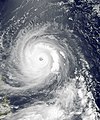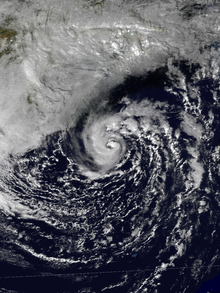
Back بوابة:الأعاصير المدارية Arabic Portal:Ciclons tropicals Catalan Portal:Ciclones tropicales Spanish 포털:태풍 Korean Portaal:Tropische cyclonen Dutch Portal:Ciclones tropicais Portuguese สถานีย่อย:พายุหมุนเขตร้อน Thai Portal:熱帶氣旋 Chinese
The Tropical Cyclones Portal

A tropical cyclone is a storm system characterized by a large low-pressure center, a closed low-level circulation and a spiral arrangement of numerous thunderstorms that produce strong winds and heavy rainfall. Tropical cyclones feed on the heat released when moist air rises, resulting in condensation of water vapor contained in the moist air. They are fueled by a different heat mechanism than other cyclonic windstorms such as Nor'easters, European windstorms and polar lows, leading to their classification as "warm core" storm systems. Most tropical cyclones originate in the doldrums, approximately ten degrees from the Equator.
The term "tropical" refers to both the geographic origin of these systems, which form almost exclusively in tropical regions of the globe, as well as to their formation in maritime tropical air masses. The term "cyclone" refers to such storms' cyclonic nature, with anticlockwise rotation in the Northern Hemisphere and clockwise rotation in the Southern Hemisphere. Depending on its location and intensity, a tropical cyclone may be referred to by names such as "hurricane", "typhoon", "tropical storm", "cyclonic storm", "tropical depression" or simply "cyclone".
Types of cyclone: 1. A "Typhoon" is a tropical cyclone located in the North-west Pacific Ocean which has the most cyclonic activity and storms occur year-round. 2. A "Hurricane" is also a tropical cyclone located at the North Atlantic Ocean or North-east Pacific Ocean which have an average storm activity and storms typically form between May 15 and November 30. 3. A "Cyclone" is a tropical cyclone that occurs in the South Pacific and Indian Oceans.
Selected named cyclone -
The 1991 Perfect Storm, also known as The No-Name Storm (especially in the years immediately after it took place) and the Halloween Gale/Storm, was a damaging and deadly nor'easter in October 1991. Initially an extratropical cyclone, the storm absorbed Hurricane Grace to its south and evolved into a small unnamed hurricane later in its life. Damage from the storm totaled over $200 million (1991 USD) and thirteen people were killed in total, six of which were an outcome of the sinking of Andrea Gail, which inspired the book and later movie, The Perfect Storm. The nor'easter received the name, playing off the common expression, after a conversation between Boston National Weather Service forecaster Robert Case and author Sebastian Junger.
The initial area of low pressure developed off the coast of Atlantic Canada on October 28. Forced southward by a ridge to its north, it reached its peak intensity as a large and powerful cyclone. The storm lashed the east coast of the United States with high waves and coastal flooding before turning to the southwest and weakening. Moving over warmer waters, the system transitioned into a subtropical cyclone before becoming a tropical storm. It executed a loop off the Mid-Atlantic states and turned toward the northeast. On November 1, the system evolved into a full-fledged hurricane, with peak sustained winds of 75 miles per hour (120 km/h), although the National Hurricane Center left it unnamed to avoid confusion amid media interest in the precursor extratropical storm. The system was the twelfth and final tropical cyclone, the eighth tropical storm, and fourth hurricane in the 1991 Atlantic hurricane season. The tropical system weakened, striking Nova Scotia as a tropical storm before dissipating. (Full article...)Selected article -
The 1970 Bhola cyclone (also known as the Great Cyclone of 1970) was a devastating tropical cyclone that struck East Pakistan (present-day Bangladesh) and India's West Bengal on November 12, 1970. It remains the deadliest tropical cyclone ever recorded and one of the world's deadliest humanitarian disasters. At least 300,000 people died in the storm, possibly as many as 500,000, primarily as a result of the storm surge that flooded much of the low-lying islands of the Ganges Delta. Bhola was the sixth and strongest cyclonic storm of the 1970 North Indian Ocean cyclone season.
The cyclone formed over the central Bay of Bengal on November 8 and traveled northward, intensifying as it did so. It reached its peak with winds of 185 km/h (115 mph) on November 10, and made landfall on the coast of East Pakistan on the following afternoon. The storm surge devastated many of the offshore islands, wiping out villages and destroying crops throughout the region. In the most severely affected upazila, Tazumuddin, over 45% of the population of 167,000 were killed by the storm. (Full article...)Selected image -

Selected season -

The 1988 Atlantic hurricane season was a near average season that proved costly and deadly, with 15 tropical cyclones directly affecting land. The season officially began on June 1, 1988, and lasted until November 30, 1988, although activity began on May 30 when a tropical depression developed in the Caribbean. The June through November dates conventionally delimit the period of each year when most tropical cyclones form in the Atlantic basin. The first cyclone to attain tropical storm status was Alberto on August 8, nearly a month later than usual. The final storm of the year, Tropical Storm Keith, became extratropical on November 24. The season produced 19 tropical depressions of which 12 attained tropical storm status. One tropical storm was operationally classified as a tropical depression but was reclassified in post-analysis. Five tropical cyclones reached hurricane status of which three became major hurricanes reaching Category 3 on the Saffir–Simpson scale.
There were two notable cyclones of the season, the first one being Hurricane Gilbert, which at the time was the strongest Atlantic hurricane on record. The hurricane tracked through the Caribbean Sea and the Gulf of Mexico and caused devastation in Mexico and many island nations, particularly Jamaica. Its passage caused $2.98 billion in damage (1988 USD) and more than 300 deaths, mostly in Mexico. The second one was Hurricane Joan, which struck Nicaragua as a Category 4 hurricane and caused about US$1.87 billion in damage and more than 200 deaths. The hurricane crossed into the eastern Pacific Ocean and was reclassified as Tropical Storm Miriam. Hurricane Debby also successfully crossed over, becoming Tropical Depression Seventeen-E, making the 1988 season the first on record in which more than one tropical cyclone has crossed between the Atlantic and Pacific basins intact. (Full article...)Related portals
Currently active tropical cyclones

Italicized basins are unofficial.
- North Atlantic (2024)
- No active systems
- East and Central Pacific (2024)
- No active systems
- West Pacific (2024)
- No active systems
- North Indian Ocean (2024)
- No active systems
- Mediterranean (2023–24)
- No active systems
- South-West Indian Ocean (2023–24)
- No active systems
- Australian region (2023–24)
- No active systems
- South Pacific (2023–24)
- No active systems
- South Atlantic (2023–24)
- No active systems
Last updated: 21:54, 8 May 2024 (UTC)
Tropical cyclone anniversaries

May 10
- 1972 - Cyclone Hannah impacts Papua New Guinea as a weak cyclone.
- 2002 - The 2002 Oman cyclone made landfall in Oman, bringing up to 250 mm (9.8 in) of rain.
- 2015 - Typhoon Noul (pictured) made landfall over in Santa Ana, Cagayan at Category 5 typhoon intensity.

May 11
- 1965 - The first of two cyclones to impact Bangladesh in 1965 made landfall on the country. These two storms collectively killed 47,000 people.
- 2019 - Cyclone Lili (pictured) made landfall over East Timor before dissipating the same day. The storm caused significant flooding over the island.

- May 12, 1991 - Typhoon Walt (pictured) reached its peak intensity to the east of the Philippines with 260 km/h (160 mph) winds. Cyclone Lisa developed in the Southern Hemisphere concurrently with Walt.
Did you know…




- …that the Joint Typhoon Warning Center considers that Typhoon Vera (pictured) of 1986 is actually two distinct systems, formed from two separated low-level circulations?
- …that Hurricane Agatha (pictured) was the strongest Pacific hurricane to make landfall in Mexico in May since records began in 1949?
- …that Cyclone Raquel (track pictured) travelled between the Australian and South Pacific basins between the 2014–15 and 2015–16 seasons, spanning both seasons in both basins?
- …that Cyclone Amphan (pictured) in 2020 was the first storm to be classified as a Super Cyclonic Storm in the Bay of Bengal since 1999?
General images -

Category 3 is the third-highest classification on the Saffir–Simpson hurricane wind scale, and categorizes tropical cyclones with 1-minute maximum sustained winds between 96 and 112 knots (110 and 129 mph; 178 and 207 km/h; 49 and 58 m/s). Tropical cyclones that attain such winds and move over land while maintaining those winds are capable of causing severe damage to human lives and infrastructure. From 1949 to 2023, a total of 85 recorded Pacific hurricanes have peaked at Category 3 strength within the Northeast Pacific tropical cyclone basin, which is denoted as the part of the Pacific Ocean north of the equator and east of the International Date Line. This does not include storms that also attained Category 4 or 5 status on the scale.
The development of Category 3 hurricanes in the Northeast Pacific basin is influenced by many factors. During the Northern Hemisphere winter and spring months of December to April, sea surface temperatures in the tropics are usually too low to support tropical cyclogenesis. Furthermore, from January to April, the North Pacific High and Aleutian Low induce strong vertical wind shear and unfavorable conditions that serve to prevent the development of hurricanes. These effects are reduced or even disappear during hurricane season from May to November, when sea surface temperatures are also high enough to support tropical cyclogenesis; the bulk of recorded Category 3 hurricanes developed during June to October. Global weather patterns may also influence hurricane development in the Northeast Pacific. El Niño events result in increased numbers of powerful hurricanes through weaker wind shear and higher sea surface temperatures within the basin, while La Niña events reduce the number of such hurricanes through the opposite. (Full article...)Topics
Subcategories
Related WikiProjects
WikiProject Tropical cyclones is the central point of coordination for Wikipedia's coverage of tropical cyclones. Feel free to help!
WikiProject Weather is the main center point of coordination for Wikipedia's coverage of meteorology in general, and the parent project of WikiProject Tropical cyclones. Three other branches of WikiProject Weather in particular share significant overlaps with WikiProject Tropical cyclones:
- The Non-tropical storms task force coordinates most of Wikipedia's coverage on extratropical cyclones, which tropical cyclones often transition into near the end of their lifespan.
- The Floods task force takes on the scope of flooding events all over the world, with rainfall from tropical cyclones a significant factor in many of them.
- WikiProject Severe weather documents the effects of extreme weather such as tornadoes, which landfalling tropical cyclones can produce.
Things you can do
 |
Here are some tasks awaiting attention:
|
Wikimedia
The following Wikimedia Foundation sister projects provide more on this subject:
-
Commons
Free media repository -
Wikibooks
Free textbooks and manuals -
Wikidata
Free knowledge base -
Wikinews
Free-content news -
Wikiquote
Collection of quotations -
Wikisource
Free-content library -
Wikiversity
Free learning tools -
Wikivoyage
Free travel guide -
Wiktionary
Dictionary and thesaurus
© MMXXIII Rich X Search. We shall prevail. All rights reserved. Rich X Search























































